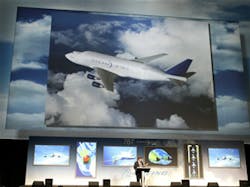Dreamliner Surpasses Efficiency and Maintenance Expectations
Boeing's newest airliner, the 787, will be even more efficient and easy to maintain when it rolls out for the first time next summer than its maker had promised airline customers, the head of the program said Wednesday.
Mike Bair, vice president in charge of the 787 Dreamliner project, said 787 operating costs will be 2 to 3 percentage points better than Boeing had predicted. The aerospace company had told customers then that the plane's operating costs would better those of its twin-engine 767 by 8 to 10 percent. But as Boeing has refined its aerodynamic design for the plane, those targets have moved even higher. The 787 with 220 to 300 seats, will replace the 767 in Boeing's lineup.
On the maintenance side, Boeing had touted the yet-to-be-built plane as improving maintenance over the 767 by 15 percent. Now that projected savings has doubled to 30 percent, Bair said.
The Boeing executive made those predictions at an Everett news conference in which he summarized the progress on the new plane in the past year.
"Things have been happening very fast in 2006," he said.
Among the major milestones:
* All of Boeing's partners have begun producing subassemblies for the first six test airplanes. That work is generally proceeding on schedule and without major glitches. Boeing has partnered with major aerospace companies in Japan, Italy, China, Germany, France, Britain, Australia, Spain and other countries to produce the 787.
* Boeing has begun destructive testing of the plane's structural elements, including a major section of the wing. That wing, the first wing built largely of composite materials in an airliner, is undergoing fatigue testing at the company's developmental center in Seattle. When that testing is done, Boeing will bend the wing until it breaks to determine how much force it can sustain. The wing is being made in Japan.
* The company has also begun virtual testing of the plane's functional systems to ferret out any glitches with those before they're installed on the plane. Initial testing has uncovered dozens of issues, Bair said, but that's not uncommon with active systems on a new plane. The virtual testing will catch those problems earlier than in the past when many of those problems weren't evident until flight test.
* The first of Boeing's three 747 Large Cargo Freighters is nearing certification. The 747LCF is a 747 greatly enlarged to carry whole 787 fuselage sections and wings from Europe, Asia, South Carolina and Kansas, where they're made, to Everett for final assembly. The second of those 747LCFs is due to arrive in Seattle from Taiwan late this year or early next year. The LCF will probably carry its first cargo, a 787 wing box, from Japan to Charleston, S.C., in January.
* Boeing engineers are steadily whittling down the 787's weight by redesigning parts and substituting materials, Bair said. Late this summer, the 787 was reported to be about 5,000 pounds overweight. Since then, the weight has been greatly reduced, Bair said. For instance, Boeing redesigned the tracks that hold the seats to the floor, saving several hundred pounds.
* A French contractor has delivered the first wiring bundle for the plane. That bundle, although one of the simpler ones to be installed in the aircraft, passed inspection with a high grade. Boeing's rival, Airbus, has seen its superjumbo airline, the A380, falter in part because its complex wiring needs to be re-engineered. Delivery of the first commercial A380 has been delayed two years because of the wiring and other problems.
* The Dreamliner has attracted 435 orders from 35 airlines and has 18 more commitments, making it the most successful airliner in Boeing history based on preproduction orders. Bair said Boeing had expected 787 orders to slack off this year, because the first four years of production are sold out, but they haven't. Customers now wanting to get a 787 will have to wait until the latter half of 2013 to receive their first 787, even if they order today, he said.
Boeing remains on course to begin assembly of the first test aircraft this spring and roll it out for the first time this summer. Flight testing will begin in August with delivery of the first commercial version of the aircraft to All Nippon Airways in the summer of 2008.
Copyright 2005 LexisNexis, a division of Reed Elsevier Inc. All rights reserved.
Terms and Conditions | Privacy Policy
News stories provided by third parties are not edited by "Site Publication" staff. For suggestions and comments, please click the Contact link at the bottom of this page.

